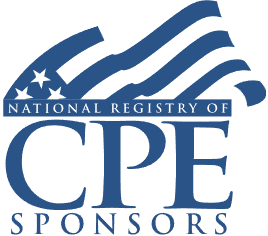Charitable Remainder Trusts: Utilizing CRATs and CRUTs to Minimize Income and Transfer Tax, SECURE 2.0 QCDs

Course Details
- smart_display Format
On-Demand
- signal_cellular_alt Difficulty Level
Intermediate
- work Practice Area
Tax Preparer
- event Date
Thursday, July 6, 2023
- schedule Time
1:00 p.m. ET./10:00 a.m. PT
- timer Program Length
110 minutes
-
BARBRI is a NASBA CPE sponsor and this 110-minute webinar is accredited for 2.0 CPE credits.
-
BARBRI is an IRS-approved continuing education provider offering certified courses for Enrolled Agents (EA) and Tax Return Preparers (RTRP).
This webinar will take a comprehensive look at charitable remainder trusts (CRTs) as a means to reduce estate and income taxes paid by taxpayers. Our notable panel will explain which taxpayers are ideal candidates for CRTs, the calculation of the remainder interest and annual pay-outs, differences in CRATs and CRUTS, and the new SECURE 2.0 provision allowing a one-time transfer to a CRAT.
Faculty

Mr. McNary has been practicing law for more than 30 years. Throughout most of his career he has limited his practice to the areas of estate planning, business succession planning, probate, and trust administration. That focus has allowed Mr. McNary to intensively study those areas of the law. He has taught many courses and written many papers for fellow lawyers and has published articles on estate planning, probate, and trust administration.

Ms. Gabbard’s practice focuses on privately held businesses, high net worth clients, and charitable organizations. Her areas of practice include all aspects of income, capital gains, gift and estate tax planning, charitable planning, advanced wealth and business succession planning, capital gains tax deferral techniques, acquisition, sale and liquidity planning, private corporate structuring, asset freeze techniques, family office planning, insurance planning, trust tax planning, and trust administration.

Mr. Stanley counsels and advises clients, including high net-worth individuals, professionals and entrepreneurs, on a wide range of sophisticated estate planning, tax and fiduciary matters. His broad practice includes estate planning and administration as well as income tax planning, with a particular emphasis in the areas of wealth transfer tax planning and wealth transfer strategies. Mr. Stanley has experience in individual estate administration, closely-held business succession planning, asset protection and tax financial planning.
Description
CRTs have been a long-standing way to simultaneously minimize estate taxes, defer income taxes, provide an annual income stream, and be philanthropic while gaining a charitable income tax deduction. Appreciated assets and company stock are ideal assets to contribute to these trusts. The trust sells the assets allowing the donee to avoid tax on the current-year gain and beneficiaries to postpone recognizing the gain until distributions are made.
As if the historical benefits weren't enough, current rising interest rates increase the IRC Section 7520 rate and the value of the charitable deduction. Additionally, the new provision in SECURE 2.0 allows up to a $50,000 qualified charitable distribution to a charitable remainder annuity trust.
Along with the benefits are caveats. These trusts are irrevocable and can be complex to administer. Using CRATs to eliminate capital gains made the IRS' dirty dozen list of tax scams in 2022. Trust and estate advisers utilizing CRTs need to understand how to avoid missteps and maximize the benefit of these trusts.
Listen as our panel of trust and estate planning experts points out the benefits and caveats of using CRTs to minimize estate and income taxes.
Outline
- Charitable remainder trusts: introduction
- Benefits
- SECURE 2.0
- CRATs
- CRUTs
- Calculations
- Caveats
- Best practices
Benefits
The panel will cover these and other critical issues:
- Preparing for IRS scrutiny of CRTs
- Calculating the remainder interest for contributions to a CRT
- Utilizing SECURE 2.0 one-time qualified charitable distribution to a CRAT
- Differences between CRATs and CRUTs
- Clients who could benefit most from CRTs
NASBA Details
Learning Objectives
After completing this course, you will be able to:
- Recognize taxpayers who would benefit the most by establishing CRTs
- Determine how the annual payout for CRTs is determined
- Identify SECURE 2.0 requirements for the one-time transfer to a CRAT
- Ascertain key differences between CRATs and CRUTs
- Field of Study: Taxes
- Level of Knowledge: Intermediate
- Advance Preparation: None
- Teaching Method: Seminar/Lecture
- Delivery Method: Group-Internet (via computer)
- Attendance Monitoring Method: Attendance is monitored electronically via a participant's PIN and through a series of attendance verification prompts displayed throughout the program
- Prerequisite: Three years+ business or public firm experience preparing complex tax forms and schedules, supervising other preparers or accountants. Specific knowledge and understanding of estate, gift and trust taxation including various trusts types, the unified credit, and portability.

Strafford Publications, Inc. is registered with the National Association of State Boards of Accountancy (NASBA) as a sponsor of continuing professional education on the National Registry of CPE Sponsors. State boards of Accountancy have final authority on the acceptance of individual courses for CPE Credits. Complaints regarding registered sponsons may be submitted to NASBA through its website: www.nasbaregistry.org.

Strafford is an IRS-approved continuing education provider offering certified courses for Enrolled Agents (EA) and Tax Return Preparers (RTRP).
Unlimited access to premium CLE courses:
- Annual access
- Available live and on-demand
- Best for attorneys and legal professionals
Unlimited access to premium CPE courses.:
- Annual access
- Available live and on-demand
- Best for CPAs and tax professionals
Unlimited access to premium CLE, CPE, Professional Skills and Practice-Ready courses.:
- Annual access
- Available live and on-demand
- Best for legal, accounting, and tax professionals
Related Courses

Identifying and Repairing Form 709 Gift Tax and GST Return Reporting Errors
Available On-Demand

Key Issues in Succession Planning: Buy-Sell Agreements, Equity Grants, Profits Interests, Tax Considerations
Friday, May 23, 2025
1:00 p.m. ET./10:00 a.m. PT

Penalty Abatement and Collections: Contesting IRS Assessments
Thursday, May 22, 2025
1:00 p.m. ET./10:00 a.m. PT
Recommended Resources
How CPE Can Bridge the Gap Between What You Know and What You Need to Know
- Career Advancement